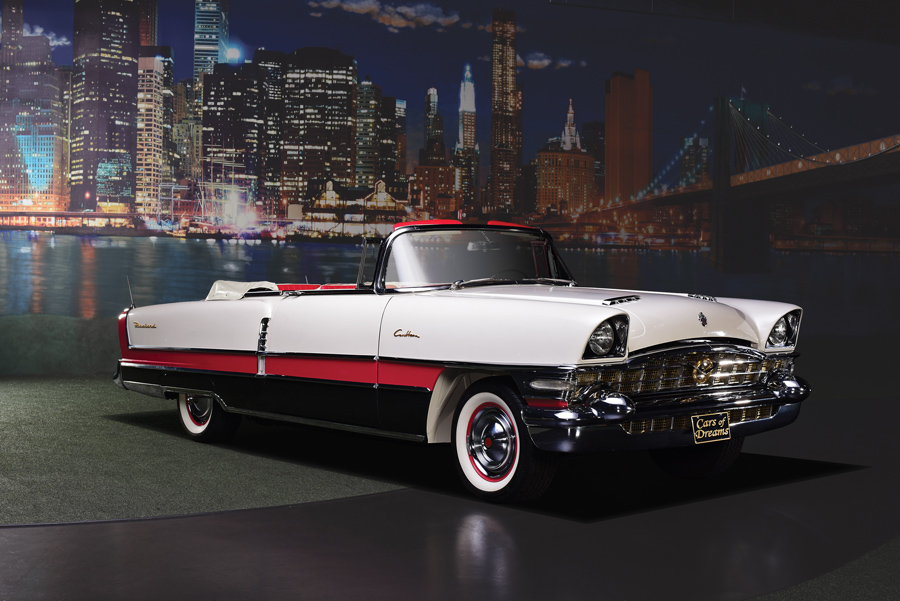SCM Analysis
Detailing
| Vehicle: | 1956 Packard Caribbean Convertible |
| Years Produced: | 1956 |
| Number Produced: | 276 (convertibles) |
| Original List Price: | $5,995 |
| SCM Valuation: | $68,000 |
| Tune Up Cost: | $350 |
| Chassis Number Location: | Plate on left front door post |
| Engine Number Location: | Boss at upper left side of cylinder block |
| Club Info: | Packards International Motor Car Club |
| Website: | http://www.packardsinternational.com |
| Alternatives: | 1956 Cadillac Eldorado Biarritz, 1956 Chrysler 300B, 1956 Lincoln Continental |
| Investment Grade: | B |
This car, Lot 696, sold for $100,100, including buyer’s premium, at Barrett-Jackson’s Palm Beach, FL, sale on April 14, 2018. It was offered with no reserve from the John Staluppi “Cars of Dreams” Collection.
For Packard, 1956 was a make-or-break year. According to Packard President James Nance, the company needed to sell 50,000 units in order “to keep from incurring horrendous losses.” The deck, however, was stacked against them, with a long list of seemingly insurmountable obstacles to overcome.
Hotpoints and halos
The ’56 was called “The Greatest Packard of Them All,” and it incorporated numerous innovative ideas from the Product Planning Division. They incorporated a “Twin Traction” differential, which was a safety feature, and the “Touch-Button Ultramatic” transmission. Nance had previously been at Hotpoint, which had made the “push button” kitchen every housewife’s dream — he figured that if it could sell stoves, it could certainly also sell cars.
The 1956 Caribbean continued as a “halo” car that was used to draw prospective buyers into the showroom. Introduced in 1953, it was based on the Pan American concept car that had been presented at the 1952 New York Auto Show.
It was initially only offered as a convertible, but a hard top was introduced in 1956. It was styled by Dick Teague and had reversible leather and bouclé seat cushions, dual heaters and defrosters, three-way radio with electric antenna, and power windows, seats and brakes.
It was equipped with power-assisted steering — a rarity for the time. Also included were wrap-around parking and taillights, side marker lights and automatic torsion leveling that aided nighttime visibility. The triple-tone paint accentuated the car’s length, and twin hood scoops completed the look. Priced at $5,995, it was truly a stunning, luxurious automobile.
End of the road
The outlook, however, was dismal. Pan American Airlines was suing Packard over ownership of the name Clipper and the suit was expanded to include the Caribbean name. General Motors was also suing Packard over patented transmission features. In addition, Lincoln-Mercury was pressuring Packard dealers to change franchises. In early 1956, Packard was losing about 20 dealers a month.
Dealers were loaded with inventory, but they were noted for holding out for full list price, and their variable net was two to three times higher than the competition. The push-button transmission, which was made by Auto-Lite, was not delivered in sufficient quantities to meet delivery schedules and was of marginal quality.
Seat production was delayed and they had to use those from the Four Hundred, causing a costly recall. In addition, the Dana Spicer rear axle failed, causing another costly recall. To make things even worse, Briggs, their body supplier, sold out to Chrysler, and Packard struggled with supply and quality issues as they implemented body production in their own Detroit factory. The Chrysler 300 and the Cadillac Eldorado set their sights on an ailing Packard.
On July 27, 1956, Studebaker-Packard Corporation entered into a joint management agreement with Curtis-Wright Corporation, which for all intents and purposes spelled the end of Packard. Only 28,835 Packards had been produced in 1956, 276 of them being Caribbean convertibles. The “Packardbakers” that followed for two more years, built after the Studebaker merger, were Packards in name only.
Auction fever
This 1956 Caribbean was from the famed John Staluppi “Cars of Dreams” Collection. Barrett-Jackson sold 144 of his cars at this year’s Palm Beach sale. For the most part, all went for strong numbers.
This car was described as being an unrestored car with a few paint touch-ups and a replaced top. It presented well overall. The reversible leather and bouclé seats had also been replaced.
The auction description provided little insight as to the mechanical condition of the car. If and when the engine might have been rebuilt was not addressed, which is a key point — if you were not able to give this a detailed inspection prior to bidding, you were certainly taking a chance.
A glance at the ACC Pocket Price Guide tells us that the median value of the 1956 Packard Caribbean convertible is $68,000, while the 1955 — which is essentially the same car — is $84,000. There are over 90 sales in the database, but only two are cars that made over $100k.
This was described as a mostly unrestored car — if the seats and top needed replacing, I have to wonder what else might lurk under the hood that isn’t as casually visible. Granted, it very well could be fine — but for the price paid here, I’d want to be sure.
This sale was an outlier by a wide margin. Collection sales almost always bring big numbers across the block, and that was likely a factor here. But we might also chalk this result up to a case of auction fever. Hopefully, no gremlins are hiding under that hood. All things considered, I’d call this well sold.
(Introductory description courtesy of Barrett-Jackson.)
